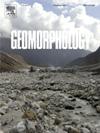Alongshore runup variability across contrasting beach states: Insights from field observations
IF 3.1
2区 地球科学
Q2 GEOGRAPHY, PHYSICAL
引用次数: 0
Abstract
Most beaches exhibit alongshore morphological variability, which is often overlooked in predictive empirical parameterizations of the runup. This study examines alongshore runup variations in relation to intertidal and subtidal morphology on an intermediate beach in the NW Pacific of Baja California. UAV imagery, combined with topographic and bathymetric measurements, was used to determine the runup elevation along a 500-m stretch of beach with diverse morphological characteristics: Terraces and Cross-shore Channels (TCC), Transverse Bar and Rip (TBR), Reflective conditions (R), and Reflective beaches with Multiple Channels (RMC). The largest runup variations were observed under intermediate conditions (TBR), where rip channels and transverse bars significantly influenced the runup. Distinct signatures associated with different morphologies were evident in the spectral shape of the swash, with well-developed rip channels promoting more incident swash unless wave breaking occurred at bars at the head of the rip. Swash showed alongshore variability ranging by a factor between 1.4 and 2.7, depending on the beach state. This factor can be much larger when evaluated over the incident and infragravity swash components. Such variability could not be explained by changes in beach slope alone. The setup, as the lower component of the runup, exhibited minimal alongshore change, with a coefficient of variation of <23 %. Wave runup, setup and swash observations were compared against various existing parameterizations. The results showed that the variability of incident swash is well captured by parameterizations based on foreshore slope and deep-water wave parameters. While predictions of infragravity swash improve when accounting for beach morphology, most of the alongshore variability remains unrepresented, particularly for milder slopes. This research highlights the influence of alongshore morphological variations on runup and underscores the necessity of incorporating these variations into parameterizations to enhance accuracy.
求助全文
约1分钟内获得全文
求助全文
来源期刊

Geomorphology
地学-地球科学综合
CiteScore
8.00
自引率
10.30%
发文量
309
审稿时长
3.4 months
期刊介绍:
Our journal''s scope includes geomorphic themes of: tectonics and regional structure; glacial processes and landforms; fluvial sequences, Quaternary environmental change and dating; fluvial processes and landforms; mass movement, slopes and periglacial processes; hillslopes and soil erosion; weathering, karst and soils; aeolian processes and landforms, coastal dunes and arid environments; coastal and marine processes, estuaries and lakes; modelling, theoretical and quantitative geomorphology; DEM, GIS and remote sensing methods and applications; hazards, applied and planetary geomorphology; and volcanics.
 求助内容:
求助内容: 应助结果提醒方式:
应助结果提醒方式:


